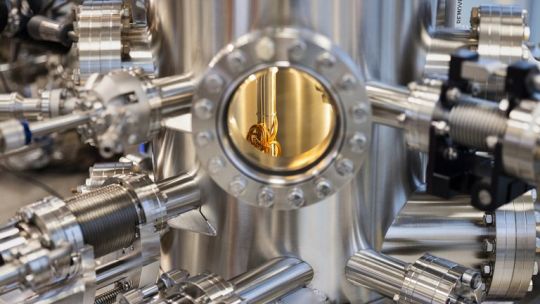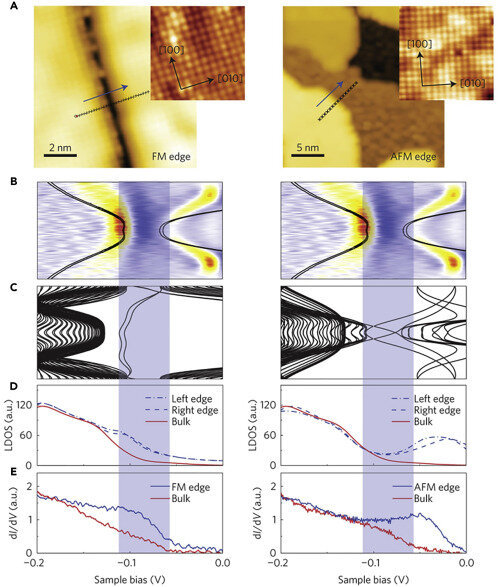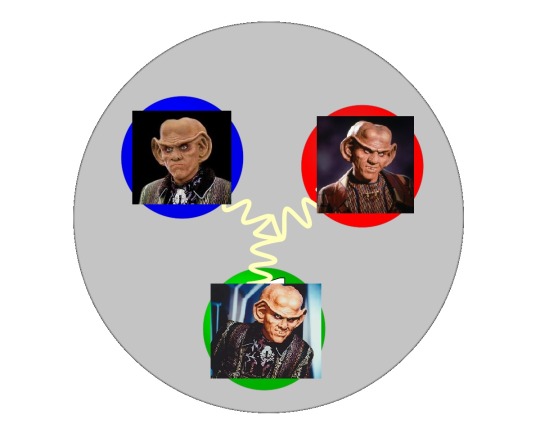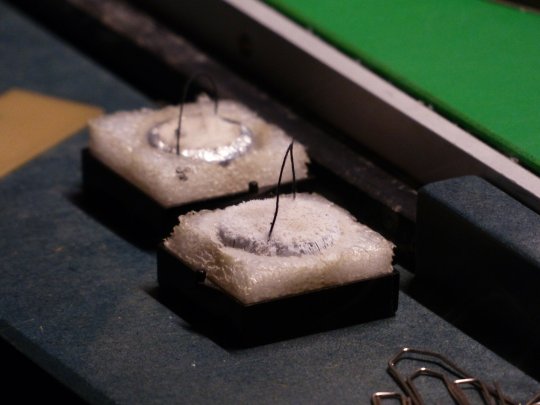#Majorana fermion
Text

Majorana
Portrait illustration for a AAAS Science article about the evasive Ettore Majorana (who disappeared without a trace in 1938) and his eponymous quasiparticle:
The Quantum Phantom – "A ghostly quasiparticle rooted in a century-old Italian mystery could unlock quantum computing’s potential—if only it could be pinned down."
Info, process & more:
P.S., from the article:
And 3 years ago, the researchers flew to UC Berkeley to visit the archive of Emilio Segrè, whose friendship with Majorana soured in the years before his disappearance. The researchers came across a folder that, per Segrè’s instructions, cannot be opened until the year 2057.
Excuse me?? I suppose I have to stick around until at least 2057 because I need to know wtf if in that folder.
#Ettore Majorana#Majorana#Majorana fermion#Majorana particle#physics#particle physics#art#SciArt#science illustration#Science#Science Magazine#Olena Shmahalo#NatureInTheory#portfolio#digital painting#NoAI#Human Artist#physics art#portrait art
15 notes
·
View notes
Text
Sigue la búsqueda de modos cero de Majorana como base para la computación cuántica
Los fermiones de Majorana son partículas elementales hipotéticas propuestas en 1937 por el físico italiano Ettore Majorana. Se distinguen de los demás fermiones (los llamados de Dirac, como el electrón, el muón, el tauón o los quarks) en que la partícula es su propia antipartícula (en física de partículas, a cada tipo de partícula se le asocia una antipartícula con la misma masa, pero con cargas…

View On WordPress
0 notes
Text
Comment on “Traversable wormhole dynamics on a quantum processor” - Bryce Kobrin, Thomas Schuster and Norman Y. Yao
Those interested in ‘wormholes-on-a-chip’ might be interested in the following article uploaded to the arXiv on Feb. 15 2023.
Comment on "Traversable wormhole dynamics on a quantum processor"
Bryce Kobrin, Thomas Schuster and Norman Y. Yao
A recent article [Nature 612, 51-55 (2022)] claims to observe traversable wormhole dynamics in an experiment. This claim is based upon performing a teleportation protocol using a Hamiltonian that consists of seven Majorana fermions with five fully-commuting terms. The Hamiltonian is generated via a machine-learning procedure designed to replicate the teleportation behavior of the Sachdev-Ye-Kitaev (SYK) model. The authors claim that the learned Hamiltonian reproduces gravitational dynamics of the SYK model and demonstrates gravitational teleportation through an emergent wormhole. We find: (i) in contrast to these claims, the learned Hamiltonian does not exhibit thermalization; (ii) the teleportation signal only resembles the SYK model for operators that were used in the machine-learning training; (iii) the observed perfect size winding is in fact a generic feature of small-size, fully-commuting models, and does not appear to persist in larger-size fully-commuting models or in non-commuting models at equivalent system sizes
https://arxiv.org/abs/2302.07897
0 notes
Text
Los fermiones de Majorana tienen potencial para la tecnología de la información con resistencia cero
El escurridizo fermión de Majorana, o «partícula de ángel» propuesta por Ettore Majorana en 1937, se comporta simultáneamente como una partícula y …Los fermiones de Majorana tienen potencial para la tecnología de la información con resistencia cero

View On WordPress
1 note
·
View note
Photo

Majorana fermions hold potential for information technology with zero resistance
0 notes
Text
Welcome anyons! Physicists find best evidence yet for long-sought 2D structures
Quantum Physics logo.
July 3, 2020
The ‘quasiparticles’ defy the categories of ordinary particles and herald a potential way to build quantum computers.
Image above: The ‘pyjama stripe’ interference pattern denotes the presence of anyons in an electronic system. Image Credits: James Nakamura and Michael Manfra.
Physicists have reported what could be the first incontrovertible evidence of the existence of unusual particle-like objects called anyons, first proposed more than 40 years ago. Anyons are latest addition to a growing family of phenomena called quasiparticles, which are not elementary particles but collective excitations of many electrons in solid devices. Their discovery — made using a 2D electronic device — could represent the first steps towards making anyons the basis of future quantum computers.
“This does look like a very big deal,” says Steven Simon, a theoretical physicist at the University of Oxford, UK. The results, which have not yet been peer reviewed, were posted on the arXiv preprint repository last week1.
Known quasiparticles display a range of exotic behaviours. For example, magnetic monopole quasiparticles have only one magnetic pole — unlike all ordinary magnets, which always have a north and a south. Another example is Majorana quasiparticles, which are their own antiparticles.
Anyons are even more unique. All elementary particles fall into one of two possible types — fermions and bosons. Anyons are neither. The defining property of fermions (which include electrons) is Fermi statistics: when two identical fermions switch spatial positions, their quantum-mechanical wave — the wave function — is rotated by 180 degrees. When bosons exchange places, their wave doesn’t change. Switching two anyons should produce a rotation by some intermediate angle, an effect called fractional statistics that can cannot occur in three-dimensional space but only as collective states of electrons confined to move in two dimensions.
Fractional statistics
Fractional statistics is the defining property of anyons, and the latest work — led by Michael Manfra, an experimental physicist at Purdue University in West Lafayette, Indiana — is the first time it has been measured so conclusively.
The quasiparticles’ unusual behaviour when switching places means that if one moves in a full circle around the other — equivalent to the two particles switching positions twice — it will retain a memory of that motion in its quantum state. That memory is one of the tell-tale signs of fractional statistics that experimentalists have been looking for.
Manfra and his team manufactured a structure of thin layers of gallium arsenide and aluminium gallium arsenide. It confines electrons to move in two dimensions, while shielding them from stray electric charges in the rest of the device. They then cooled it to 10 thousandths of a degree above absolute zero and added a strong magnetic field, producing a state of matter called a ‘fractional quantum Hall’ (FQH) insulator that has the peculiarity that no electrical current can run in the interior of the two-dimensional device, but can run along the edge. FQH insulators can host quasiparticles that have an electric charge that is not a multiple of the electron charge, but one-third of one: these quasiparticles have long been suspected to be anyons.
To prove that they were indeed anyons, the team etched the device so that it could carry currents from one electrode to another along two possible edge paths. They tweaked the conditions by varying the magnetic field and adding an electric field. These tweaks were expected to create or destroy anyon states stuck in the interior, and also to produce anyons running between the electrodes. Because moving anyons had two possible paths, each producing a different twist in their quantum-mechanical waves, when the anyons reached the end point their quantum-mechanical waves produced an interference pattern called pyjama stripes.
This pattern shows how the relative amount of rotation between the two paths varies in response to changes in the voltage and the magnetic-field strength. But the interference also displayed jumps, which were the smoking gun2 for the appearance or disappearance of anyons in the bulk of the material.
“As far as I can tell, it is an extremely solid observation of anyons — directly observing their defining property: that they accumulate a fractional phase when one anyon travels around another,” Simon says.
It is not the first time that researchers have reported evidence of fractional statistics. Robert Willett, a physicist at Nokia Bell Labs in Murray Hill, New Jersey, says that his team saw “strong evidence” for fractional statistics in 20133.
And other teams have probed a different property that makes anyons an intermediate between fermions and bosons. Fermions obey the Pauli exclusion principle: no two fermions can ever occupy the same exact quantum state. But bosons have no such restrictions. Anyons are in the middle — they do bunch, but not as much as bosons do, as an experiment described in April in Science reported. “It is strikingly different from the fermionic behavior that we can also probe in the same set-up,” says Gwendal Feve, an experimentalist at the Sorbonne University in Paris who led that effort.
Quantum computing
But some theoretical physicists say that the evidence in these and other experiments, although striking, was not conclusive. “In many cases, there are several ways of explaining an experiment,” says Bernd Rosenow, a condensed-matter theorist at the University of Leipzig in Germany. But the evidence reported by Manfra’s team, if confirmed, is unequivocal, Rosenow says. “I’m not aware of an explanation of this experiment which is plausible and does not involve fractional statistics.”
The work potentially lays ground work for the application of anyons. Simon and others have invented some elaborate schemes to use anyons as the platform for quantum computers. Pairs of the quasiparticle could encode information in their memory of how they have circled around one another. And because the fractional statistics is ‘topological’ — it depends on the number of times an anyon went around another, not on slight changes to its path — it is unaffected by tiny perturbations. This robustness could make topological quantum computers easier to scale up than current quantum-computing technologies, which are error-prone. Microsoft (which employs Manfra as a consultant) has been alone in pursuing the topology path for quantum computing, while other large companies, including IBM, Intel, Google and Honeywell have invested in other approaches.
Topological quantum computing will require more sophisticated anyons than those Manfra and colleagues have demonstrated; his team is now redesigning their device to do just that. Still, anyon applications are a way off, researchers warn. “Even with this new result it is very hard to see [fractional quantum-Hall] anyons as a strong contender for quantum computing,” Simon says.
But the quasiparticles’ unique physics is worth exploring: “To me, as a condensed-matter theorist, they are at least as fascinating and exotic as the Higgs particle,” says Rosenow.
Majorana quasiparticles: https://www.nature.com/news/a-solid-case-for-majorana-fermions-1.10174
Nature doi: 10.1038/d41586-020-01988-0
References:
1. Nakamura, J., Liang, S., Gardner, G. C. & Manfra, M. J. https://arxiv.org/abs/2006.14115 (2020).
2. Bartolomei, H. et al. Science 368, 173–177 (2020).
Google Scholar: http://scholar.google.com/scholar_lookup?&journal=Science&volume=368&pages=173-177&publication_year=2020&author=Bartolomei%2CH.
3. Willett, R. L. et al. Phys. Rev. Lett. 111, 186401 (2013).
Google Scholar: http://scholar.google.com/scholar_lookup?&journal=Phys.%20Rev.%20Lett.&volume=111&publication_year=2013&author=Willett%2CR.%20L.
4. Rosenow, B. & Stern, A. Phys. Rev. Lett. 124, 106805 (2020).
PubMed: http://www.ncbi.nlm.nih.gov/entrez/query.fcgi?cmd=Retrieve&db=PubMed&dopt=Abstract&list_uids=32216381
Article: https://doi.org/10.1103%2FPhysRevLett.124.106805
Google Scholar: http://scholar.google.com/scholar?q=10.1103%2FPhysRevLett.124.106805
Download references: https://www.nature.com/articles/d41586-020-01988-0-references.ris
Image (mentioned), Text, Credits: Nature/Davide Castelvecchi.
Greetings, Orbiter.ch
Full article
32 notes
·
View notes
Note
26, 34 for the ask thing?
26. Is there anything you’ve wanted to write, but you’ve been too scared to try?
Partially answered in my last response-- no, not really. I suppose things I'm scared to try includes "writing diverse OCs," because there are all kinds of things I don't know, and research can only take me so far. But I try to write them anyway, because people exist, and i want my OCs to feel like people.
34. Copy and paste an excerpt you’re particularly fond of.
(from a yet-to-be-published chapter of Twelve Days:)
Roxanne leans forward, frowning a little. “Hey. Why are you telling us all this?” she asks. “Not that it isn’t welcome! Your timing is…serendipitously perfect. But when you said there’s a lot of competition…” She glances at Megamind. “He is your competition. Unless I’m missing something?”
Doctor Horrible frowns over at her, the humorless twist of his mouth easing slightly. “He’s not, really,” he says. “He’s only ever been concerned with Metro. And this…the resources I’m seeing going missing? Whoever’s behind this is interfering with my supply lines. My interests are…fairly niche. I may be an anarchototalitarian, but I know when something concerns all of us.” He looks at Megamind. “I’m hoping you’ll tell me I’m wrong.”
Megamind is staring into the middle distance, his head tipped forward, mouth resting on his steepled fingers. Roxanne can’t help but smile a little despite the grim conversation—it’s so strange to see him sitting like this, talking like this, in regular clothing.
“Hm? Oh.” Megamind sits up a little, but his gaze is still far away. “No. I wish I could, but you probably aren’t. What are you missing?”
“A surprising quantity of yttrium,” Doctor Horrible says. “Scandium. A few other lanthanides. Two separate shipments of contained single-domain nanoparticles. Liquid helium-4 in a Bose-Einstein condensate. Non-baryonic photoparticles. P—”
Megamind snaps into focus; Roxanne sees it happen. “Axions,” he says, his tone almost questioning as he pulls his head up on his long neck, blinking. “Non-baryonic single-domain—you’re building neuromorphic motherboards with cold dark matter as a base.”
Doctor Horrible sits up a little, too, at that, and he loses some of his scowl.
Megamind cocks his head. “Are we talking heat-assisted magnetic? Bit-patterned? Skyrmion spin-based? If you’re using yttrium as the upper and lower contact—wait, what other lanthanides, exactly?” His eyes are sparkling with interest. “We are talking ferrofluid-fueled drones, yes? That’s where you’re going with this.”
“Wait. You…can’t just.” Doctor Horrible waves his hands. “Skyrmion spin-based…?”
“Topological distortions in magnetization of superparamagnetic liquids,” Megamind says, as though this is anything remotely like an explanation, but Horrible’s expression clears. “You nail down the sextuple-spin interactions and you pretty much eliminate the issue of charge-conjugation parity symmetry—”
“Oh, charge parity,” Doctor Horrible scoffs. “I mean, sure, or you could just force neutrinoless double-beta decay, which is much easier, provided you have the containment necessary to—”
“—yes, because I’m definitely going to waste a whole reactor generating enough Majorana fermions to make that feasible—”
“You keep them in their vacuum state!” Doctor Horrible exclaims. “It’s a stochastic process, for crying out loud. I’m talking canonical quantisation, not path integrals.”
(Roxanne bites her lip, trying not to laugh. This is the most entertaining conversation she’s never been part of. It’s like watching a game of table tennis.)
“Right, yes, but canonical quantisation doesn’t hold up under the non-linear sigma model you have to use for double-beta decay.” Megamind shakes his head. “It doesn’t work. And we’re getting sidetracked. Ferrofluids? Hyperferrofluids?” He cocks his head the other way this time, showing all his teeth in a wicked shark-wide smile, his eyes glittering. “What are you building with all this?”
Doctor Horrible is really grinning, at this point, but he still hesitates.
“Come on,” Megamind says, drumming his hands on his knees. He’s sitting up straight, now, both feet on the ground. “Come on, come on. You can’t give me all this and not tell me.”
“It’s—” He makes a sort of inarticulate grasping gesture. Looks at Megamind. “You know mosquitoes?”
Megamind blinks at him a couple times. Doctor Horrible makes another gesture, this one a sort of there you go, there it is, and Megamind’s eyebrows fly up and he bursts out laughing, clapping a couple times and rubbing his palms together. “Oh! Oh, ho ho, that’s bad, I love it.”
The sliding door scudds open, and Wayne pokes his head out. “There you are,” he begins, and then jumps back when Megamind explodes out of his chair in a flurry of flailing hands.
“Go away!” he hisses, all flashing eyes and bared teeth. “Go away go away I do not want you here!”
“Jeez, okay,” Wayne says, startled, and closes the door.
#askbasket#asingerofdreams#dal is a fanfic#Megamind#those aren't just buzzwords thrown together willy-nilly; i did A LOT of googling#and trawling Wikipedia#trying to find a topical flow that made some sense
4 notes
·
View notes
Text
i think physics visualizations should use little pictures of the people the things are named after

these bosons can occupy the same state because satyendra bose loved parties, but fermions cannot occupy the same state, because enrico fermi was kind of a wallflower

this is a majorana particle, which is its own antiparticle because, uh, ettore majorana mysteriously disappeared

quarks
23 notes
·
View notes
Photo

Observation of non-trivial superconductivity on surface of type II Weyl semimetal
Topological superconductors, with bulk superconducting gap and Majorana fermion states on the surface or edge, are one of the most sought after quantum materials. Topological superconductivity is of fundamental importance with potentially powerful applications in topological quantum computation. The discovery of Weyl semimetals—in which the conduction and valence bands contact only at Weyl points in the Brillouin zone protected against gap formation by crystalline symmetry or time reversal symmetry—has stimulated great enthusiasm for exploring topological superconductivity in these materials. Especially, the superconductivity from the topological non-trivial surface state of Weyl semimetals could be very attractive but has not been reported yet.
The noncentrosymmetric orthorhombic TaIrTe4, has been considered as a time-reversal invariant Weyl semimetal with the minimal 4 Weyl points. Recently, Prof. Jian Wang and Xiong-Jun Liu at Peking University in collaboration with Minghu Pan at Huazhong University of Science and Technology and others reported the experimental evidences for the unconventional superconductivity generated by the surface states in TaIrTe4 from both scanning tunneling microscopy/ spectroscopy (STM/STS) and electrical transport measurements. They demonstrated the superconductivity of TaIrTe4 by both the superconducting gap from STS and the consistent resistance drop from electrical transport. The thickness-independent of ultralow critical current and angular dependence of upper critical field (Bc2) indicate that the superconductivity occurs only in the surface states. Furthermore, the temperature dependence of Bc2 behavior, the in-plane angle-dependent critical field and the stability of the superconductivity against the magnetization together support the p-wave-like topological nature of the quasi-1D superconductivity.
Read more.
#Materials Science#Science#Superconductivity#Superconductors#Topological superconductors#Weyl semimetals#Tantalum#Iridium#Tellurium
17 notes
·
View notes
Text
Los fermiones de Majorana tienen potencial para la tecnología de la información con resistencia cero
Una nueva revisión FLEET de múltiples nodos, publicada en Matter, investiga la búsqueda de fermiones de Majorana en superconductores a base de hierro.
El escurridizo fermión de Majorana, o “partícula de ángel” propuesta por Ettore Majorana en 1937, se comporta simultáneamente como una partícula y una antipartícula, y sorprendentemente permanece estable en lugar de ser autodestructivo.
Los…

View On WordPress
0 notes
Photo

Quantum Computing Breakthrough: First Sighting of Mysterious Majorana Fermion on Gold https://ift.tt/2RoHEdp
11 notes
·
View notes
Text
An exotic quantum state known as a "chiral Majorana fermion" is predicted in devices wherein a superconductor is affixed on top of a quantum anomalous Hall (QAH) insulator (left panel). Experiments performed at Penn State and the University of Würzburg in Germany show that the millimeter-size superconductor strip used in the proposed device geometry creates an electrical short, preventing the detection of chiral Majoranas (right panel). Credit: Cui-zu Chang, Penn State
2 notes
·
View notes
Link
Authors: Hai-Feng Lu, Hai-Zhou Lu, Shun-Qing Shen
Due to their nonlocality, qubits nested in Majorana bound states may be the key to realize decoherence-free quantum computation. Majorana bound states could be achieved at the ends of a one-dimensional topological superconductor. However, when the bound states couple directly to electron reservoirs their nonlocal correlation is quenched by local Andreev reflections. Here we propose a scheme to generate nonlocal noise cross correlation between two well-separated quantum dots, mediated by a pair of Majorana bound states. Both positive and negative cross correlations can be obtained by tuning the gate voltages applied to the dots. Within a limited range of finite temperatures, the cross correlation is not suppressed by thermal fluctuations. Furthermore, we show how the local Andreev reflections suppress the noise cross correlation when multiple dot energy levels are coupled to the Majorana bound states. The measurable cross correlation is expected to serve as a sensitive indicator for the generation of Majorana fermions.
3 notes
·
View notes
Link
In the material studied, a mercury telluride quantum well coupled to superconducting thin-film aluminium, the physicists observed for the first time a topological phase transition which implies the appearance of Majorana fermions in phase-controlled Josephson junctions.
18 notes
·
View notes
Photo

The Army Wants to Use a Theoretical Particle To Make an Unhackable Quantum Computer Last July, a group of researchers from UC Irvine, UCLA, and Stanford announced they’d found the first strong evidence of the Majorana fermion, an elusive particle first theorised over 80 years ago that acts as its own antiparticle.
#Army#Computer#Environment#Future#Kang Wang#Lei Pan#Majorana Fermion#motherboard#Particle#Quantum#quasiparticles#Science#Stanford#technology#Theoretical#topological quantum computer#UC Irvine#UCLA#Unhackable#us army
0 notes
Link
In 1937, the Italian theoretical physicist Ettore Majorana extended Dirac’s theory, predicting that among fermions, there should be some particles, since named Majorana fermions, that are indistinguishable from their antiparticles. Mysteriously, the physicist disappeared during a ferry trip off the Italian coast just a year after making his prediction.
i love majorana fermions because it’s almost impossible to write about them without vaguely implying that ettore majorana somehow applied his knowledge of them to aid in his disappearance... like, nobody is willing to draw the obvious comparison between majorana himself and majorana’s fermions in reputable print, but i will: it has never been observed, but majorana may have been his own antiself, which would explain why nobody can explain his disappearance
29 notes
·
View notes